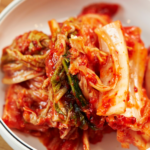Kimchi
Equipment
- Fermenting Crock
- weights
- Cabbage stomper
Ingredients
For the Brine:
- 2 gallons unchlorinated water
- 2 cups unrefined sea salt
For the Kimchi
- 10 lbs napa cabbage
- 2 cups daikon radish, shredded
- 2 cups shredded carrots
- 18 cloves cloves garlic, peeled and minced
- 1 small yellow onion, sliced very thin
- 1 cup green onions, sliced into ½ inch pieces
- 1/4 cup ginger, peeled and minced
- 1 tbsp organic cane sugar
- 1 cup gochugaru (korean chili powder)
- 1/4 cup tapioca starch tapioca starch is a thickener. You can add it if you like the kimchi liquid to not be so runny.
Instructions
- Prepare the brine by mixing the water and sea salt together in a very large mixing bowl until the salt dissolves. You can also split the brine into two bowls using 1 gallon of water and 1 cup of salt per bowl if your bowl isn’t big enough.
- Wash the cabbage in cool water.
- Remove and reserve a few of the large outermost leaves of the cabbage for later.
- With the remaining cabbage, slice the cabbages into quarters and place into the brine.
- Add a plate over the top of the cabbages. Then add your weights over that to keep the cabbage submerged in the brine.
- Let the cabbage soak in the brine for 4-6 hours.
- After soaking, reserve 3 cups of brine and set aside. (Don’t forget this step!)
- Then drain the cabbage in a colander.
- Chop cabbage into bite size pieces and place in a very large bowl.
- Add radishes, carrots, garlic, onion, chinese chives, ginger, gochugaru, and sugar. If you are adding the optional sweet rice flour, stir it in at this point. Mix well.
- Transfer the mixed vegetables and spices into your fermentation crock a little at a time, using the stomper to firmly push down the vegetables, Packing as tightly as possible.
- Place your weights on top.
- Add the reserved brine but ONLY ENOUGH to cover all the vegetables by a little bit, it could be anywhere from a 1/2 cup to 3 cups depending on the freshness of your vegetables. Additional liquid will release from the vegetables during the first few days of the ferment. Adding too much brine will result in a kimchi that is too salty and watered down.
- Cover the crock with a plate, lid, or towel, and let ferment in a cool, dark area for 7-28 days. You can begin taste testing at 7 days. The longer you ferment the more pickled the flavor will become.
- When the ferment is finished, remove kimchi from the crock and place in individual mason jars with lids. Recipe yield is approximately 5 quarts of kimchi.
- Kimchi should be stored in the refrigerator when the ferment is finished. It can also be stored in a root cellar as long as it hovers between 32 and 40ºF. Under these conditions, kimchi will stay fresh for nine months to one year.
Notes
*Sometimes during the fermentation process you’ll see a white film form on the top of the brine. This is called scum and is harmless. Use a sieve to scoop off any film you see. *Instead of adding sugar, try adding a ¼ cup asian pear, julienned. *You can also experiment with different vegetables and amounts to your taste. Just be sure to keep the salt to water ratio in the brine the same. Salt helps keep the bad bacteria away and helps the good bacteria to flourish. *Ideal fermentation temperature is between 55 and 75ºF. When fermenting in a room temperature at the warmer end of the spectrum the fermentation process happens faster. On the cooler end of the spectrum it will take longer to ferment.
